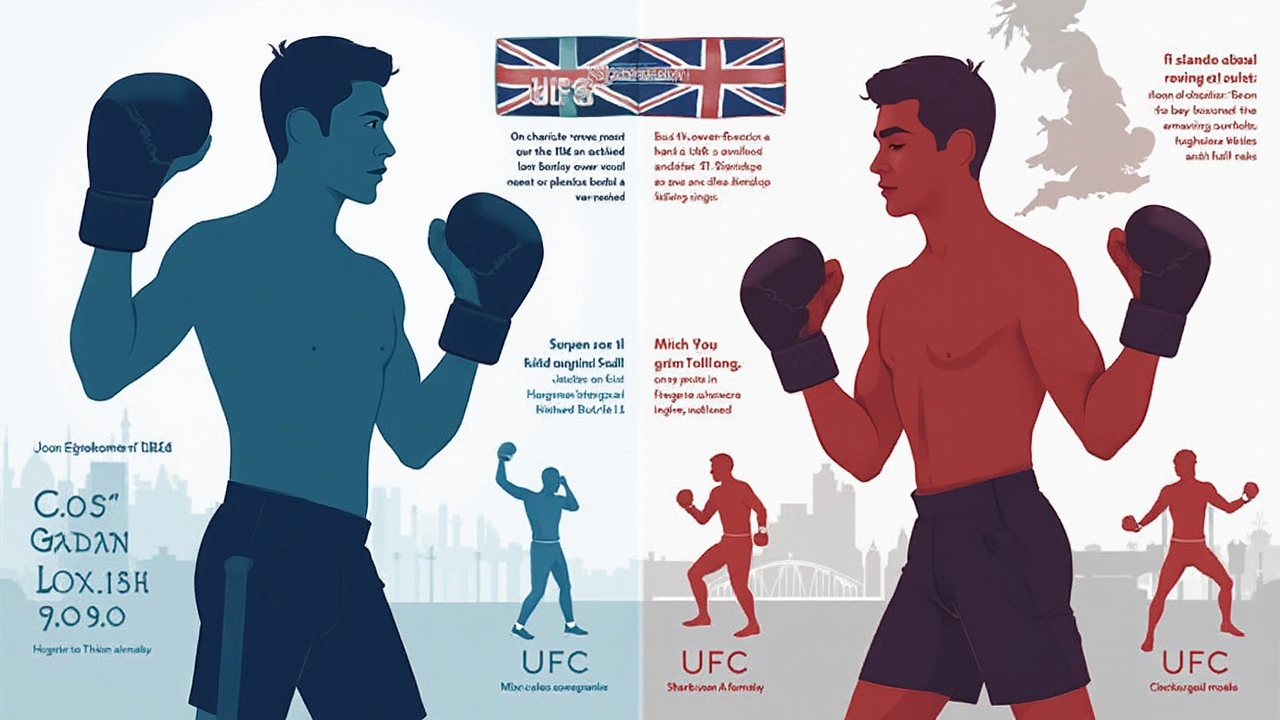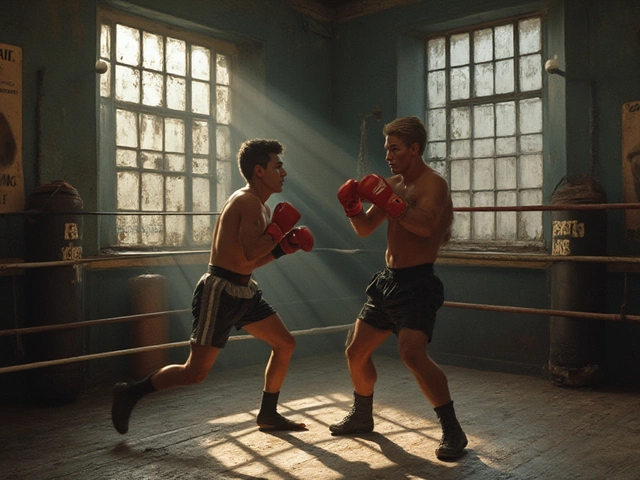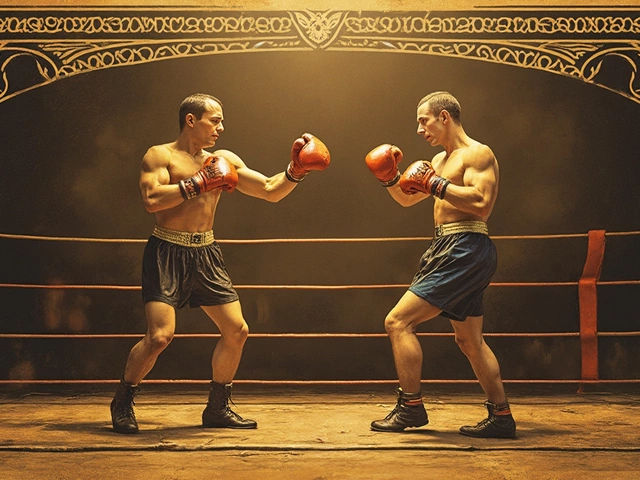If you pop open a pay-per-view and see two people throwing punches, it’s easy to assume you’re watching boxing. But when folks are grappling, kicking, or launching a flying knee, that’s a whole different sport—usually UFC, which actually means 'Ultimate Fighting Championship' and not a fighting style at all. UFC is a brand, not a sport. The actual sport is mixed martial arts, or MMA.
Here’s the thing: boxing is punches only. You're not going to see a boxer take down his opponent and try for a choke hold, because that’s not in the boxing rulebook. UFC fights, on the other hand, are wild. Fighters can punch, kick, elbow, wrestle, and even go for submission holds—all in one match. So if someone asks whether UFC is boxing, the answer is straight-up no; they’re two different worlds with their own rules, gear, and skills.
If you sit down to compare a boxing match with a UFC bout, you’ll notice more than just different types of punches. Boxing uses big, padded gloves and focuses on footwork and head movement. UFC fighters wear smaller gloves and need to watch out for everything—knees, takedowns, and submissions. That’s why boxing rounds last longer, but UFC rounds are shorter and even the stance is different.
- Why People Mix Up UFC and Boxing
- What Makes a Boxing Match
- How UFC Matches Work
- Big Differences in Rules and Gear
- Choosing Between UFC and Boxing
Why People Mix Up UFC and Boxing
A lot of people get UFC and boxing mixed up because, well, both have fighters in a ring throwing punches. It doesn’t help that huge UFC events get promoted almost like big boxing matches, with weigh-ins, hyped press conferences, and shiny title belts on the line. On the surface, if you’re just channel surfing, it’s easy to think you’re watching the same kind of fight.
The media blurs the lines too. Sports broadcasters sometimes throw around terms like “fight night,” “undercard,” or “knockout artist,” which pop up in boxing and UFC coverage. Even the ring or cage layout looks visually similar unless you’re paying attention. But underneath these similarities, the sports work totally differently.
Check out what fans often see when comparing both sports:
| Feature | Boxing | UFC/MMA |
|---|---|---|
| Venue | Boxing ring | Octagon cage |
| Main Attire | Boxing gloves, shorts, shoes | Small gloves, shorts (no shoes) |
| Allowed Strikes | Punches only | Punches, kicks, knees, elbows |
| Fight Length | Up to 12 rounds (3 min each) | 3-5 rounds (5 min each) |
Here’s another twist: some of today’s biggest sports stars cross over between the two. You might remember when Conor McGregor (a UFC champ) boxed Floyd Mayweather back in 2017. That kind of cross-promotion just adds to the confusion. Fans flip back and forth, making the line between UFC and boxing look even fuzzier.
Not to mention, both are headliners in pay-per-view events, fill out arenas, and attract the same kind of highlight-driven social media attention—knockouts go viral whether they happen in a ring or a cage. So unless you watch often or follow the rules, you might mix them up too.
What Makes a Boxing Match
When you hear 'boxing', think punches only, and nothing else is allowed. The sport is hundreds of years old and sticks to a pretty strict rulebook. Fighters compete with big gloves, shorts, and mouthguards, standing upright the whole time. The idea is simple: outscore your opponent or knock them out before the final bell.
Boxing matches are always between two people. Strikes below the belt, hitting with the back of the hand, kicking, or wrestling aren’t just frowned upon—they’ll get you disqualified. So you’ll never catch a boxer going for a leg kick or jumping on someone’s back.
Here’s what every standard boxing match has:
- Two fighters, standing up, in a square ring (usually 16 to 20 feet across)
- Gloves weighing between 8 and 10 ounces
- Rounds: Usually 3 minutes each, with a 1-minute break in between
- Number of rounds: Most pro fights go 12 rounds, amateur matches do fewer
- Referee inside the ring, judges outside scoring each round
Fights are won in three main ways:
- Knockout (the other guy can’t get up by 10)
- Technical knockout (the ref stops it for safety)
- Judges’ decision (if it goes all rounds, the scores count)
Judges mainly score based on clean punches, defense, and ring control. For example, tossing out a hundred wild shots won’t help if none of them actually hit. That’s why good boxers focus on accuracy, speed, and footwork.
Here’s a quick look at some basic facts about boxing matches:
| Element | Boxing Match Details |
|---|---|
| Ring Size | 16–20 ft square |
| Glove Size | 8–10 oz |
| Number of Rounds (Pro) | Up to 12 |
| Allowed Strikes | Punches only |
| Main Gear | Gloves, shorts, mouthguard |
The *strongest* keyword for this section is boxing, since everything from the rules to the scoring focuses on the art of punching and defense, not just brute force. That’s what separates it from UFC and other combat sports.

How UFC Matches Work
You might see folks in a cage on fight night, but a UFC match is anything but random brawling. It's a top-level MMA event, which means a bunch of rules keep things fair and keep the fighters safe. To start, UFC fights happen inside an octagon—a big, eight-sided cage. That's built to let fighters move around without getting stuck in a corner.
Normally, a standard UFC fight is three rounds, with each round lasting five minutes. For championship fights or main event bouts, you get five rounds. There's a one-minute break between each round so fighters can regroup and get advice from their coaches.
Fighters don't just throw anything that comes to mind. Here’s what’s allowed:
- Punches, kicks, and elbows while standing
- Knees (with limits to avoid dangerous head injuries)
- Takedowns (throwing or taking your opponent to the ground)
- Wrestling and jiu-jitsu moves on the ground, including submissions like chokes and joint locks
However, you can't headbutt, bite, poke eyes, or hit the groin. There’s a full list of illegal moves, and referees are strict.
Matches can end several ways:
- Knockout (one fighter can't continue from a legal strike)
- Submission (one fighter taps out or signals they can't go on)
- Ref stoppage (ref thinks it’s unsafe to continue)
- Decision (if the fight goes the full distance, judges decide the winner using a 10-point scoring system)
Scoring is a bit like boxing, but judges also look at things like grappling, cage control, and effective aggression—not just clean punches. Here’s a quick breakdown of some key UFC match stats:
| Category | Boxing | UFC (MMA) |
|---|---|---|
| Rounds | Up to 12 (major bouts) | 3 (standard) / 5 (championship) |
| Round Duration | 3 minutes | 5 minutes |
| Allowed Strikes | Punches | Punches, kicks, elbows, knees |
| Surface | Square Ring | Octagon Cage |
| Glove Size | 8-10 oz | 4-6 oz |
While the UFC is its own league, that big UFC logo on the mat just stands for high-level mixed martial arts competition. Knowing these details not only helps you enjoy the spectacle but also gives you an edge if you ever step into a gym to train.
Big Differences in Rules and Gear
Comparing boxing and UFC means looking at two totally different rulebooks. Boxing is pretty strict—only punches above the belt are allowed, no hitting behind the head, and definitely no elbows, knees, or kicks. UFC, on the other hand, is way more flexible. Fighters in UFC can use punches, kicks, elbows, knees, takedowns, and even submission holds like chokes and armbars. The main idea in UFC is to let a fighter use whatever martial arts background they want, whether it’s wrestling, jiu-jitsu, kickboxing, or something else.
Rounds and fight length are also a big deal. Most pro boxing matches go for 12 rounds, three minutes each. UFC fights are usually just three rounds of five minutes (five rounds for title fights). This completely changes the fight tempo. Because boxing matches are longer, boxers have to pace themselves differently than someone fighting in the UFC.
Gear is another huge difference. Boxers wear big, almost pillow-like gloves (at least 8-10 ounces for pros) to protect their hands and soften blows a bit. UFC fighters wear much smaller gloves—just 4 ounces most of the time—so punches feel a lot heavier. Plus, UFC gloves leave the fingers exposed for grappling, while boxing gloves cover the whole hand. In boxing, mouthguards and trunks are required, but that’s pretty much it. In UFC, fighters wear mouthguards, open-fingered gloves, shorts (with no top), and a groin guard. No shoes or shin guards are allowed in UFC.
| Feature | Boxing | UFC/MMA |
|---|---|---|
| Main Weapon | Punches only | Punches, kicks, elbows, knees, grappling |
| Glove Type | Padded, closed (8-10 oz) | Small, open-fingered (4 oz) |
| Fight Length | 12 x 3 min rounds (pro) | 3 x 5 min rounds (5 for championship) |
| Allowed Techniques | Punches above the belt | Punches, kicks, submissions, wrestling |
| Protective Gear | Mouthguard, trunks, gloves | Mouthguard, gloves, shorts, groin guard |
Another direct impact of these differences: the pace and danger of each sport. The knockout rate in UFC (over 50% of fights end before the final horn) is way higher than in pro boxing, partly because those little gloves offer barely any padding. If you’re watching to see crazy finishes, the UFC just brings a different type of risk and excitement thanks to its rule set and gear choices.

Choosing Between UFC and Boxing
Picking between boxing and UFC really depends on what you want out of a combat sport. If you’re drawn to fast hand-speed, dodging punches, and a focus on upper body movement, boxing is your lane. It’s all about mastering a few key moves and making them perfect. If you’d rather try a sport where anything can happen—kicks, grappling, punches, and plenty of surprises—the UFC world (technically, MMA) gives you that mix.
One big factor is the style of training. Boxing gyms put you through drills to fine-tune your jab and improve footwork. You spar, you hit the mitts, you work the bag, and you run a lot for endurance. Classes are pretty focused, and the rules limit what you can practice.
MMA gyms (where future UFC fighters start) work on everything—boxing, wrestling, jiu-jitsu, Muay Thai. Some gyms split each session, like striking one day and grappling the next, so you'll pick up more skills but need way more time to feel competent at all of it.
There’s also the gear. Boxing uses 10-16 ounce gloves and mouthguards and sometimes headgear if you’re new or sparring. MMA fighters use 4-ounce gloves, shin pads, and sometimes wear rash guards for grappling. Injuries can happen in both, but MMA battles have more chances for bruises and joint strains because of kicks and submissions, not just punches.
- If you’re a fan who just wants to watch, UFC brings unpredictable fights but boxing brings high-level strategy—Mayweather’s defense or Tyson Fury’s reach is a different show from Conor McGregor’s all-out fights.
- If you just want to get in shape, boxing burns calories and tones your upper body. MMA training will get your entire body working, especially your core, legs, and grip strength.
- Bout length is also different; pro boxing fights can go up to 12 rounds (each three minutes), but UFC title bouts are five rounds of five minutes. Less time, but way more happens per round in UFC.
If you can’t decide, try a trial class in both at a local gym. You’ll know in one sweaty hour which challenge feels right. The biggest thing? Neither is "better" than the other. It’s about what excites you when the bell rings or the cage door locks. Just remember, while boxing is part of MMA, the reverse isn’t true—so you’re picking between one style or the whole toolbox.
And for anyone still scratching their head, no, watching UFC doesn’t mean you’re watching boxing. They're just two fighters on the same pay-per-view planet, but in totally different sports universes.








